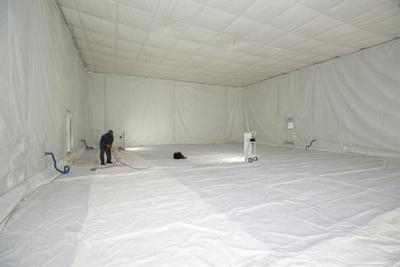Testing Intended To Demonstrate Survivability Of The Airplane In Such Scenarios
After years of preparation, the 461st Flight Test Squadron and Joint Strike Fighter Integrated Test Force are ready to test the F-35 Lightning II’s ability to be decontaminated from chemical and biological weapons exposure.

Contractors, Airmen and Air Force civilians have tirelessly worked in the high desert heat the past few weeks to finalize construction of a decontamination system and facility to house and decontaminate an F-35A.
It will be the first time an F-35 has been decontaminated and will show the Defense Department and joint-partner nations that the F-35 has met the F-35 Joint Program Office’s requirements for decontamination, certifying the weapon system to go into full-rate production. The effort is to demonstrate the fifth-generation fighter’s survivability can be maintained if exposed to such threats around the world. “Our focus is on the (aircraft’s decontamination ability), and that’s what we’re here to prove,” said Joe Nemes, the Air Force Research Laboratory chemical and biological project lead engineer.
The AFRL is the lead organization responsible for developing the test plan and techniques for gathering decontamination data for analysis for the F-35 Joint Program Office.
Beginning in August, the aircraft will be contaminated several times and then towed into the decontamination facility to see if it can be cleaned of chemical or biological weapons exposure. The F-35 used for testing contains modifications to specifically collect data while being tested in the air or on the ground. “Because these are tests we’re doing here, there’s an extensive amount of sensors and test equipment that we’re going to use to analyze and make sure the plane is clean. But, in the real world, theoretically, you put it in (the decontamination facility) and run the system, pull the jet out and go fly,” Nemes said.
For the tests, the F-35A will be “contaminated” with simulants, which are elements that have been researched and tested to be safe, but mimic the properties of harmful agents.
Each test procedure will be conducted in three parts.

“To contaminate the aircraft for our tests, we’re going to do engine runs at a different location (on the flightline) from the decontamination structure. We’re going to spray simulant down the engine inlet and let it get distributed throughout the interior of the aircraft,” said Melanie Link, the 461st chemical and biological 06 project lead. “Once that contamination is done, the F-35 will get towed to the decontamination shelter and decontaminated. During decontamination, samples will be taken from both the aircraft and surrounding environment so we’ll have a baseline to see the effectiveness of how the decontamination process is working from beginning to end.”
Once complete they’ll tow it to a third site and collect more samples and conduct another engine run to verify no damage was done to the aircraft.
The decontamination shelter takes about four weeks to construct and is nearly complete. It consists of four components. The first is an external air beam shelter, which protects an inner structure -- the aircraft enclosure. The tent is there to protect the enclosure from the elements such as wind loads, solar loads and everything else the desert climate will present throughout the system's roughly six-month tour here. The aircraft enclosure allows the plane to be simultaneously decontaminated externally and internally within walls made up of insulated panels.
The other two parts of the system will decontaminate the F-35 by exposing it to high temperatures. The heat is created by large capacity field heaters and the Tactical Cargo and Rotary Wing Aircraft Decontamination systems. They deliver a desired high level of heat for a specified length of time. “If we started at a level of contamination and then run the (decontamination) process, and we see that the contamination is lower, we’ve met our goal, regardless of the (decontamination) system,” Nemes said.
Testing will be conducted through December, and if all goes well, additional testing will be conducted with a Marine Corps F-35B from the operational fleet in early 2017. Those efforts will be the final decontamination tests for the F-35 Joint Program Office.
(Images provided with USAF news release)
 ANN's Daily Aero-Linx (04.13.24)
ANN's Daily Aero-Linx (04.13.24) ANN's Daily Aero-Term (04.13.24): Beyond Visual Line Of Sight (BVLOS)
ANN's Daily Aero-Term (04.13.24): Beyond Visual Line Of Sight (BVLOS) Airborne 04.09.24: SnF24!, Piper-DeltaHawk!, Fisher Update, Junkers
Airborne 04.09.24: SnF24!, Piper-DeltaHawk!, Fisher Update, Junkers Aero-News: Quote of the Day (04.14.24)
Aero-News: Quote of the Day (04.14.24) ANN's Daily Aero-Term (04.14.24): Maximum Authorized Altitude
ANN's Daily Aero-Term (04.14.24): Maximum Authorized Altitude




